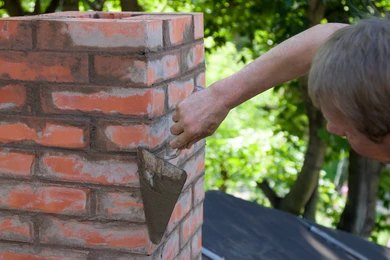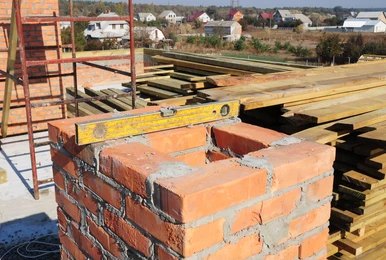
Building a masonry chimney is an important project that requires a good understanding of materials and techniques. This guide will help you learn the basics of constructing a chimney, including the necessary steps and materials involved. Whether you’re looking to add a chimney to your home or replace an old one, knowing how to build a masonry chimney can be a valuable skill.
Key Takeaways
- A masonry chimney is primarily made from bricks or stones, ensuring safe removal of smoke and gases.
- Planning is crucial; assess the location and obtain any necessary permits before starting.
- A strong foundation is essential for stability; use concrete and ensure proper reinforcement.
- Building the chimney involves laying bricks carefully, ensuring they are level and aligned.
- Regular maintenance, including checking for cracks and cleaning, is key to keeping your chimney safe and functional.
Understanding Masonry Chimneys
Definition and Purpose
A masonry chimney is a vertical structure made from bricks or stones. Its main job is to safely remove smoke and gases from fireplaces, stoves, or other heating devices. This chimney is crucial for keeping homes safe by ensuring harmful substances are expelled from living spaces.
Key Components
A masonry chimney has several important parts:
- Chimney Stack: The tall part that extends above the roof.
- Flue: The passage that carries smoke and gases out.
- Chimney Cap: A cover that prevents rain and debris from entering.
Benefits of Masonry Chimneys
Masonry chimneys offer many advantages:
- Durability: They can last for many years with proper care.
- Fire Safety: They help prevent fires by directing smoke outside.
- Aesthetic Appeal: They can enhance the look of a home.
Regular maintenance is key to ensuring your chimney remains functional and safe. By simply sealing the bricks and the crown and adding a chimney cap, you’ll greatly extend your chimney’s life. The materials cost less than $300.
Understanding these aspects of chimney masonry helps homeowners appreciate their importance. For those looking for chimney masonry repair near me, knowing the components and benefits can guide you in making informed decisions about maintenance and repairs.
Planning and Preparation for Building a Masonry Chimney

Before you start your project, it’s important to plan and prepare properly. This will help ensure a successful build. Here are the key steps to follow:
Assessing the Location
- Choose a spot for your chimney that is close to your fireplace or stove.
- Make sure the location looks good and fits well with your home’s design.
- Check for any nearby trees or structures that might block the chimney.
Obtaining Necessary Permits
- Look into local building codes to find out what permits you need.
- Apply for the required permits before starting construction to avoid any legal issues.
- Keep all paperwork organized and accessible during the project.
Gathering Essential Materials
To build your chimney, you will need several materials. Here’s a list of what to gather:
- Bricks and stones: Choose durable materials that can withstand heat.
- Mortar and cement: These will hold your bricks together.
- Flue liners and chimney caps: These are important for safety and efficiency.
| Material Type | Purpose |
|---|---|
| Bricks | Structure of the chimney |
| Mortar | Bonding agent for bricks |
| Flue liners | Ventilation for smoke |
| Chimney caps | Protection from debris and weather |
Proper planning and preparation are essential for building a masonry chimney. Taking the time to assess your location, obtain permits, and gather materials will lead to a smoother construction process.
By following these steps, you will be well on your way to understanding how to build a masonry chimney effectively!
Constructing the Foundation
Excavation and Formwork
To build a strong chimney, you need a solid foundation. Start by digging a trench where the chimney will go. Make sure this trench goes below the frost line to prevent freezing issues. After that, create a form using wood or metal to shape the foundation.
Reinforcement and Pouring Concrete
Next, add reinforcement bars inside the form. This will help make the foundation stronger. Once the bars are in place, pour concrete into the form. Ensure the concrete is level and well-compacted. Let it cure according to the instructions provided by the manufacturer.
Ensuring a Level Base
After the concrete has cured, check that the base is level. A level base is crucial for the stability of your chimney. You can use a level tool to confirm this. If adjustments are needed, you can add more concrete or smooth out any uneven areas.
A solid foundation is the key to a long-lasting chimney. Without it, the entire structure may be at risk.
Summary of Steps
- Excavate the trench below the frost line.
- Build the formwork to shape the foundation.
- Add reinforcement bars for strength.
- Pour and level the concrete.
- Check for a level base before proceeding.
Building the Chimney Structure

Laying the First Course of Bricks
To start building your chimney, you need to lay the first course of bricks. This is a crucial step because a solid base ensures stability. Here’s how to do it:
- Prepare the mortar: Mix the mortar according to the instructions on the package. It should be thick enough to hold the bricks in place.
- Lay the bricks: Start placing the bricks on the foundation. Use a level to make sure they are even.
- Check alignment: Use a plumb line to ensure the bricks are straight up and down.
Constructing the Chimney Stack
Once the first course is set, you can build the chimney stack. Follow these steps:
- Add more courses: Continue stacking bricks, making sure to stagger the joints for strength.
- Install the flue liner: This is important for proper ventilation. The flue liner can be made of clay or metal.
- Secure the structure: Use mortar to fill gaps and ensure everything is tightly held together.
Installing the Flue Liner
The flue liner is essential for directing smoke out of the chimney. Here’s how to install it:
- Choose the right liner: You can use clay tiles or metal pipes.
- Position the liner: If using clay, lay the tiles as you build the chimney. For metal, drop it into place once the structure is built.
- Seal the joints: Make sure all connections are sealed to prevent leaks.
Building a chimney requires careful attention to detail. A well-constructed chimney not only functions better but also enhances the safety of your home.
Summary
Building the chimney structure involves laying bricks, constructing the stack, and installing the flue liner. Each step is important for ensuring that your chimney is safe and effective. Remember to check your work frequently to maintain alignment and stability. A strong chimney is key to a safe home.
Finishing Touches and Maintenance

Creating Clean Mortar Joints
To ensure your chimney looks great and functions well, it’s important to have clean mortar joints. Here are some steps to achieve this:
- Remove excess mortar from the joints using a trowel.
- Use a brush to clean the joints thoroughly.
- If needed, apply a mortar joint tool to shape the joints neatly.
Installing Flashing and Chimney Cap
Proper installation of flashing and a chimney cap is essential to prevent water damage. Follow these steps:
- Install flashing around the base of the chimney to direct water away.
- Secure the chimney cap on top to keep out rain and debris.
- Check for any gaps and seal them with a waterproof sealant.
Regular Maintenance Tips
To keep your masonry chimney in good shape, consider these maintenance tips:
- Inspect the chimney regularly for cracks or damage.
- Clean the flue at least once a year to prevent creosote buildup.
- Scoop up a handful of the sealer and wipe it onto the crown. Force the sealant into the cracks and into the crown-to-brick seam.
Regular maintenance is key to ensuring the longevity and safety of your masonry chimney. Don’t overlook small repairs, as they can lead to bigger issues later on!
Common Materials Used in Masonry Chimneys

Masonry chimneys are built using a variety of materials that ensure they are strong and can withstand heat. Here are some of the common materials used:
Bricks and Stones
- Bricks: These are the most common material used in masonry chimneys. They are durable and can handle high temperatures.
- Natural Stones: Stones like granite or marble can also be used. They add a unique look and are very strong.
- Concrete Blocks: These are often used for the chimney’s foundation and can support the structure well.
Mortar and Cement
- Mortar: This is a mixture used to hold bricks and stones together. It is essential for the stability of the chimney.
- Refractory Mortar: This special type of mortar can withstand high heat, making it perfect for the inner parts of the chimney.
Flue Liners and Chimney Caps
- Flue Liners: These are installed inside the chimney to direct smoke and gases outside. They can be made of clay or metal.
- Chimney Caps: Positioned on top of the chimney, these caps prevent rain and debris from entering the flue.
| Material Type | Description |
|---|---|
| Bricks | Durable and heat-resistant |
| Natural Stones | Unique appearance and strong |
| Concrete Blocks | Provides solid support for the chimney |
| Mortar | Binds bricks and stones together |
| Refractory Mortar | Withstands high temperatures |
| Flue Liners | Directs smoke and gases safely outside |
| Chimney Caps | Protects the chimney from weather elements |
Understanding the materials used in masonry chimneys is crucial for ensuring their safety and effectiveness. Proper selection and installation can lead to a long-lasting chimney that functions well for years to come.
Safety Considerations for Masonry Chimneys
Fire Safety Measures
To ensure safety when using a masonry chimney, it is essential to follow these fire safety measures:
- Regular inspections: Have a professional inspect your chimney at least once a year.
- Clean the flue: Remove any creosote or debris that can cause fires.
- Use a chimney cap: This prevents animals and debris from entering the chimney.
Structural Integrity
Maintaining the structural integrity of your chimney is crucial. Here are some key points to consider:
- Check for cracks: Look for signs of crumbling bricks or deteriorating mortar.
- Inspect the chimney crown: Ensure it is intact to prevent water damage.
- Monitor for leaks: Address any water leaks immediately to avoid further damage.
Weatherproofing and Insulation
Proper weatherproofing and insulation can help protect your chimney from the elements. Consider the following:
- Use quality materials: Ensure that bricks and mortar are suitable for outdoor conditions.
- Install flashing: This helps to direct water away from the chimney.
- Add insulation: Insulating the chimney can prevent heat loss and protect against freezing.
Regular maintenance is key to preventing serious issues. Addressing problems like crumbling bricks or water leakage promptly can save you from costly repairs later on.
By following these safety considerations, you can ensure that your masonry chimney remains safe and functional for years to come.
Contact Apex Contractors Inc. for Expert Masonry Services
Building a masonry chimney can be complex. Trust the experts at Apex Contractors Inc. to handle your project with precision and care. Whether you’re building a new chimney or need repairs on an existing one, we’re here to help every step of the way.
Connect with us on social media for updates, tips, and project highlights:
- Instagram: @ApexContractors
- Facebook: Apex Contractors Inc.
Get in touch with us today to make your chimney project a success
